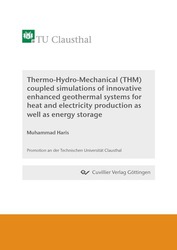| Areas | |
|---|---|
| Serie de libros (96) |
1378
|
| Nachhaltigkeit |
3
|
| Gesundheitswesen |
1
|
| Letra |
2364
|
| Ciencias Naturales |
5406
|
| Ciencias Ingeniería |
1793
|
| Ingeniería | 292 |
| Ingeniería mecánica y de proceso | 862 |
| Ingeniería eléctrica | 686 |
| Mineria y metalurgía | 30 |
| Arquitectura e ingeniería civil | 75 |
| General |
98
|
|
Leitlinien Unfallchirurgie
5. Auflage bestellen |
|
Erweiterte Suche
Thermo-Hydro-Mechanical (THM) coupled simulations of innovative enhanced geothermal systems for heat and electricity production as well as energy storage (Tienda española)
Muhammad Haris (Autor)Previo
Lectura de prueba, PDF (1,5 MB)
Indice, PDF (160 KB)
Enhanced geothermal systems (EGSs) evolved from the hot dry rock can provide a significant amount of energy while shifting towards negligible carbon emission. In order to investigate some important issues related to EGS, several scenarios have been analyzed using powerful numerical tools (FLAC3Dplus and TOUGH2MP-TMVOC). While conducting multiple hydraulic fracturing, it is observed that the newly created successive fracture’s configuration highly depends on the previous one under the influence of stress shadow. Therefore, the assumption of using similar multiple fracture geometries and shapes for energy exploitation may lead to erroneous estimations. A case study has been performed further using the engineering data of the GeneSys project in the North German Basin. Numerous scenarios have been investigated, and the optimized EGS project is proposed, whose installed power capacity of one side of the injection well declines from 7.17 MW to 5.08 MW over 30 years. Moreover, the Levelized cost of electricity is calculated at 5.46 c$/kWh, which is quite economical compared to the current electricity price. Finally, an innovative concept of regenerative EGS is proposed by storing surplus renewable energy in multiple hydraulic fractures that can reduce the reservoir temperature reduction rate. The results of continuous injection/production cycles depicted that a regenerative EGS could be achieved in reality.
| ISBN-13 (Impresion) | 9783736976603 |
| ISBN-13 (E-Book) | 9783736966604 |
| Formato | A5 |
| Idioma | Inglés |
| Numero de paginas | 172 |
| Laminacion de la cubierta | mate |
| Edicion | 1. |
| Lugar de publicacion | Göttingen |
| Lugar de la disertacion | Clausthal |
| Fecha de publicacion | 05.08.2022 |
| Clasificacion simple | Tesis doctoral |
| Area |
Ciencias Ingeniería
|
| Palabras claves | Geothermie, Verbesserte geothermische Systeme, Erneuerbare Energie, Niedrige Kohlenstoffemissionen, Numerische Simulationen, Wärmeleitung, Wärmekonvektion, THM-Kopplung, Geothermische Kraftwerke, Weltweite EGS-Projekte, Hydraulische Bruchmodellierung, Wechselwirkungen zwischen Fluidströmungen, FLAC3Dplus, TOUGH2MP-TMVOC, Fiktives Modell, Wärmeerzeugung, GeneSys EGS-Projekt, Norddeutsches Becken, Verlaufsabgleich, Mehrfaches hydraulisches Fracking, Sequentielles hydraulisches Fracking, Bruchgeometrie, Bruchabstand, horizontale Vertiefungen, Spannungsschatteninterferenz, Massives stimuliertes volumen, Optimierung der Energieerzeugung, Stromerzeugung, Bohrlochabstand, Flüssigkeitsdurchfluss, Wirtschaftsanalyse, Nivellierte Stromkosten, Strompreis, Windenergie, Solarenergie, überschüssige Energie, Thermische Energiespeicherung, Injektions-/Produktionszyklen, Rückgewinnungsfaktor, Speichereffizienz, regeneratives EGS. Geothermal energy, Enhanced geothermal systems, Renewable energy, Low carbon emission, Numerical simulations, Heat conduction, Heat convection, THM coupling, Geothermal power plants, Worldwide EGS projects, Hydraulic fracture modeling, Fluid flow interactions, FLAC3Dplus, TOUGH2MP-TMVOC, Fictive model, Heat production, GeneSys EGS project, North German Basin, History matching, Multiple hydraulic fracturing, Sequential hydraulic fracturing, Fracture geometry, Fracture spacing, Horizontal wells, Stress shadow interference, Massive stimulated volume, Energy production optimization, Electricity generation, Well spacing, Fluid flow rate, Economic analysis, Levelized cost of electricity, Electricity price, Wind energy, Solar energy, Surplus energy, Thermal energy storage, Injection/production cycles, Recovery factor, Storage efficiency, Regenerative EGS. |








